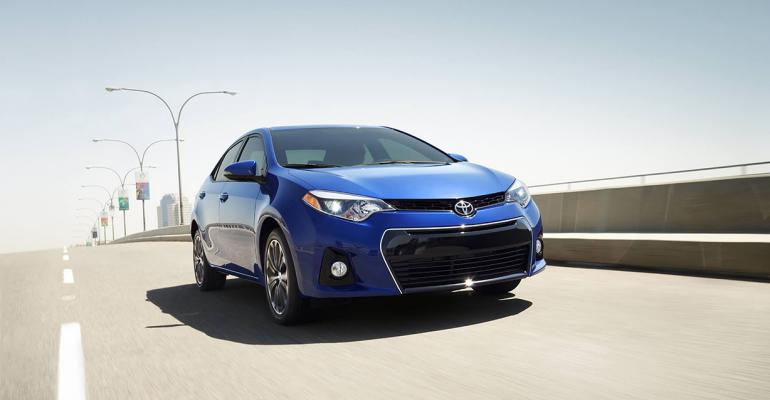TOKYO – The weak yen is only one reason most Japanese automakers are making money more quickly than they can count it, industry analyst Chris Richter says.
Bolstered by a yen trading about ¥120:$1, down 27% since the end of 2012, as many as five automakers are on track to report record earnings in the fiscal year ending March 31.
But years of deep cost-cutting, consolidating platforms, expanding production outside Japan and pinpoint focus on product planning also have lifted the companies out of the depths of the recession triggered by the 2008 collapse of Lehman Brothers, says Richter, of CLSA Asia-Pacific Markets.
“It’s all happened below the surface,” he says. “And now the fruits of their labors are showing up on the bottom line.”
Toyota, the industry’s largest seller, is projecting earnings of ¥2.7 trillion ($22.3 billion), up from last year’s record ¥2.3 trillion ($19.0 billion), on sales of ¥26.5 trillion ($218.5 billion), also a new high.
Mazda, Mitsubishi and Fuji Heavy Industries, maker of Subaru cars, all are on track to surpass their fiscal 2013 highs. Suzuki is a maybe.
Toyota, Mazda and Fuji reported losses in fiscal 2008; it was Toyota’s first shortfall in nearly 70 years.
Mazda is on track to register a ¥210.0 billion ($1.7 billion) profit, up from last year’s record ¥182.1 billion ($1.5 billion), on sales of ¥2.9 trillion ($24.1 billion). Sales still are well below Mazda’s ¥3.5 trillion ($28.7 billion) peak in fiscal 2007. However, the automaker almost surely will register a 7.2% operating profit margin, 50% higher than its previous best.
More importantly, it has taken steps to reduce its currency-exchange exposure, for decades an Achilles’ heel, by setting up a production base in Salamanca, Mexico, where it has built Mazda2 and Mazda3 models since February 2014.
But even before the Salamanca plant went on line, Mazda had lowered its cost structure through the vertical integration of its model lineup. The first breakthrough product was the Mazda6, launched in November 2013 when the exchange-rate break-even point was ¥80:$1.
Overseas Production Shift Pays Off for Mitsubishi
Similarly, Mitsubishi has turned the corner after years aboard a largely forex-driven roller coaster. Although managing a tiny ¥3.9 billion ($32 million) profit in fiscal 2008, most analysts were unimpressed as the company still was producing two-thirds of its vehicles in Japan.
Overseas production, mostly in Southeast Asia, now accounts for 50% of output and is growing. As a result, the automaker is projecting record fiscal 2014 earnings of ¥135.0 billion ($1.1 billion), following last year’s record, on sales of ¥2.2 trillion ($17.9 billion).
Mitsubishi’s sales are well below fiscal 2007 peak levels. Meaning, as with Mazda, Mitsubishi’s earnings margin will be an historic high 6.2%.
Subaru, which Richter reports has the biggest profit margin among all Japanese brands at 14.4%, is on track to report a ¥410.0 billion ($3.4 billion) profit, up from its original forecast of ¥382.0 billion ($3.1 billion), on record sales of ¥2.85 trillion ($23.4 billion), also up from its original forecast.
While Honda and Nissan will not report record earnings, both have seen profits rebound sharply from fiscal 2008 levels. Honda earned ¥161.7 billion ($1.3 billion) in fiscal 2008 and projects a ¥720.0 billion ($5.9 billion) profit. Nissan lost ¥172.7 billion ($1.4 billion) in 2008 and anticipates a ¥570.0 billion ($4.7 billion) profit this year.
Suzuki and Daihatsu, Japan’s leading manufacturers of 0.66L minicars, remained profitable even during the dark days following the Lehman Brothers bankruptcy and after a massive earthquake and tsunami struck the northeastern coast of Japan in March 2011, virtually stopping vehicle production for three months.
Both Suzuki and Daihatsu, a Toyota subsidiary, reported record earnings in fiscal 2013. Suzuki, if it meets its targets, will report marginally higher earnings in the current fiscal year on the strength of its India operations, where it ranks as the country’s leading brand. Its fiscal 2014 target is ¥188.0 billion ($1.6 billion) on sales of ¥3.0 trillion ($24.8 billion). Sales still are 15% below fiscal 2007 peak levels.
Daihatsu is projecting a 25.0% decline in earnings.
In fiscal 2008 the dollar averaged ¥100.2:$1, a year in which all Japanese automakers reported losses or substantially lower profits. In fiscal 2013, the dollar stood at ¥100.5:$1. In the intervening years, the U.S. currency averaged ¥85.1:$1.
With no apparent pressure for a weaker dollar, Japanese automakers are considering bringing production back to the country, but not in significant volumes, according to analyst Koji Endo at Advanced Research Japan. Likely candidates are Honda and Nissan, both of which build cars outside Japan that share platforms with domestic models.
Also reflecting the industry’s improved cost structure is the fact that domestic manufacturers are exporting cars profitably, and not just luxury models and hybrids. Since crashing to a 13-year low in fiscal 2009, exports have rebounded and held steady at about 4.6 million units annually since then.





